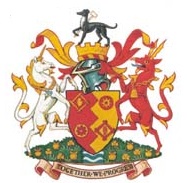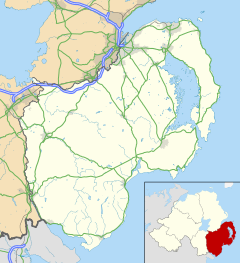Lurgan is a town in County Armagh, Northern Ireland, near the southern shore of Lough Neagh and roughly 18 miles (29 km) southwest of Belfast. The town is linked to Belfast by both the M1 motorway and the Belfast–Dublin railway line. Lurgan had a population of about 28,634 at the 2021 UK census, and falls within the Armagh, Banbridge and Craigavon district. For certain purposes, Lurgan is treated as part of the "Craigavon Urban Area", along with neighbouring Craigavon and Portadown.

Lisburn is a city in Northern Ireland. It is 8 mi (13 km) southwest of Belfast city centre, on the River Lagan, which forms the boundary between County Antrim and County Down. First laid out in the 17th century by English and Welsh settlers, with the arrival of French Huguenots in the 18th century, the town developed as a global centre of the linen industry.

Royal Hillsborough, more commonly known simply as Hillsborough, is a village and civil parish in County Down, Northern Ireland, 19 km (12 mi) from the city of Belfast. It is within the Lisburn and Castlereagh District Council area. The village is noted for its Georgian architecture. It is home to Hillsborough Castle, the British royal family's official residence in Northern Ireland, and residence of the British Secretary of State for Northern Ireland.

Lagan Valley is a parliamentary constituency in the United Kingdom House of Commons. The current MP is Sir Jeffrey Donaldson, leader of the Democratic Unionist Party (DUP) until his resignation in March 2024. The constituency has always returned unionist MPs, but is considered competitive between the DUP and the Alliance Party for the forthcoming 2024 election.

Banbridge was a local government district in Northern Ireland. The district was one of 26 council areas formed on 1 October 1973, following the implementation of the Local Government Act 1972. The headquarters of the council were in the town of Banbridge. In April 2015, most of the Banbridge district was included in the merged Armagh, Banbridge and Craigavon district. Some smaller areas in the east of the district became merged with the Newry, Mourne and Down District

Craigavon Borough Council was a local council in counties Armagh, Down and Antrim, in Northern Ireland. It merged with Armagh City and District Council and Banbridge District Council in May 2015 under local government reorganisation in Northern Ireland to become Armagh, Banbridge and Craigavon District Council.

Dromore is a small market town and civil parish in County Down, Northern Ireland. It lies within the local government district of Armagh City, Banbridge and Craigavon. It is 19 miles (31 km) southwest of Belfast, on the A1 Belfast–Dublin road. The 2011 Census recorded a population of 6,395.

Gilford is a village in County Down, Northern Ireland. The village sits on the River Bann between the towns of Banbridge, Tandragee and Portadown. It covers the townlands of Loughans, Ballymacanallen and Drumaran. It had a population of 1,933 people in the 2011 Census. Gilford is within the Armagh, Banbridge and Craigavon district.

Rathfriland is a market town in County Down, Northern Ireland. It is 8 miles (13 km) north-east of Newry town centre.
Lambeg is a small village and civil parish in County Antrim, Northern Ireland. Located between Belfast and Lisburn, it was once a small rural village, but is now within the Greater Belfast conurbation. Lambeg is also an electoral ward of Lisburn Council. In the 2001 Census it had a population of 60 people. The civil parish of Lambeg covers areas of County Down as well as County Antrim.

Waringstown is a large village in County Down, Northern Ireland. It lies southeast of Lurgan, within the parish of Donaghcloney, and the barony of Iveagh Lower, Lower Half. In the 2011 Census it had a population of 3,683 people. Over the years, the village has been bestowed numerous awards, including "Best Kept Small Town" for its floral displays and pleasant appearance.

Gamblestown is a small village in County Down, Northern Ireland about 1.5 km from Donaghcloney, on the Lurgan to Dromore road. It is situated in the Parish of Magheralin and the townland of Clogher. In the 2001 Census it had a population of 159 people. It is situated to the southeast of the Craigavon Borough Council area.
Broomhedge is a small village in County Antrim, Northern Ireland, near Lisburn, approximately 12 miles (19 km) southwest of Belfast. It lies within the Lisburn and Castlereagh City Council area, and the Maghaberry electoral ward.

John Baptist Crozier was a Church of Ireland bishop. He served as Bishop of Ossory, Ferns and Leighlin (1897–1907), Bishop of Down, Connor and Dromore (1907–1911), Primate of All Ireland and Archbishop of Armagh (1911–1920).

Banbridge is a town in County Down, Northern Ireland. It lies on the River Bann and the A1 road and is named after a bridge built over the River Bann in 1712. It is situated in the civil parish of Seapatrick and the historic barony of Iveagh Upper, Upper Half. The town began as a coaching stop on the road from Belfast to Dublin and thrived from Irish linen manufacturing. The town was home to the headquarters of the former Banbridge District Council. Following a reform of local government in Northern Ireland in 2015, Banbridge became part of Armagh City, Banbridge and Craigavon Borough Council. It had a population of 17,400 in the 2021 Census.
Iveagh was a constituency of the Parliament of Northern Ireland.
Rob Lyttle is a rugby union player from Donaghcloney, County Down, Northern Ireland. He plays wing for Banbridge RFC, having spent seven seasons with Ulster.
Lagan River is one of the seven district electoral areas (DEA) in Armagh City, Banbridge and Craigavon, Northern Ireland. The district elects five members to Armagh City, Banbridge and Craigavon Borough Council and contains the wards of Donaghcloney, Dromore, Gransha, Quilly and Waringstown. Lagan River forms part of the Upper Bann constituencies for the Northern Ireland Assembly and UK Parliament and part of the Lagan Valley constituencies for the Northern Ireland Assembly and UK Parliament.

























